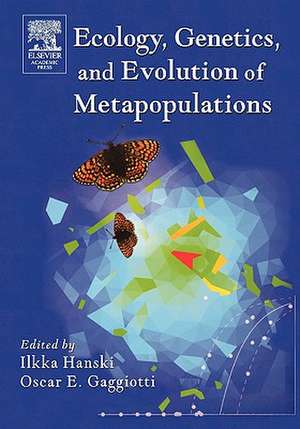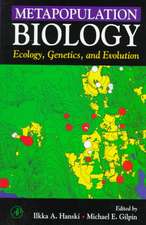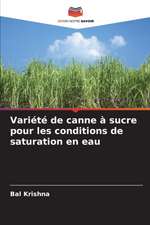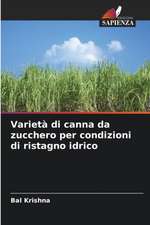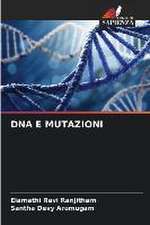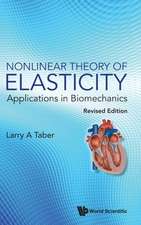Ecology, Genetics and Evolution of Metapopulations
Editat de Ilkka A. Hanski, Oscar E. Gaggiottien Limba Engleză Paperback – 16 mai 2004
The extensive coverage of theory from highly regarded scientists and the many substantive applications in this one-of-a-kind work make it invaluable to graduate students and researchers in a wide range of disciplines.
- Provides a comprehensive and authoritative account of all aspects of metapopulation biology, integrating ecology, genetics, and evolution
- Developed by recognized experts, including Hanski who won the Balzan Prize for Ecological Sciences
- Covers novel applications of the metapopulation approach to conservation
Preț: 374.67 lei
Preț vechi: 460.08 lei
-19% Nou
Puncte Express: 562
Preț estimativ în valută:
71.70€ • 76.66$ • 59.78£
71.70€ • 76.66$ • 59.78£
Carte tipărită la comandă
Livrare economică 10-24 aprilie
Preluare comenzi: 021 569.72.76
Specificații
ISBN-13: 9780123234483
ISBN-10: 0123234484
Pagini: 696
Dimensiuni: 175 x 254 x 37 mm
Greutate: 1.23 kg
Ediția:New.
Editura: ELSEVIER SCIENCE
ISBN-10: 0123234484
Pagini: 696
Dimensiuni: 175 x 254 x 37 mm
Greutate: 1.23 kg
Ediția:New.
Editura: ELSEVIER SCIENCE
Public țintă
Population geneticists, theoretical ecologists, evolutionary biologists, and anyone interested in structure of populations. Researchers, faculty and graduate students in these and related disciplines. Libraries at institutions with strong programs in population biology, ecology and genetics.Cuprins
Table of contents
Contributors
Preface
Introduction
Chapter 1 Metapopulation biology: Past, present, and future
Chapter 2 Metapopulation dynamics: Perspectives from landscape ecology
Chapter 3 Continuous-space models for population dynamics
Metapopulation ecology
Chapter 4 Metapopulation dynamics in highly fragmented landscapes
Chapter 5 Application of stochastic patch occupancy models to real metapopulations
Chapter 6 From metapopulations to metacommunities
Metapopulation genetics
Chapter 7 Selection and drift in metapopulations
Chapter 8 Metapopulations and coalescent theory
Chapter 9 Metapopulation quantitative genetics: The quantitative genetics of population differentiation
Evolutionary dynamics in metapopulations
Chapter 10 Life history evolution in metapopulations
Chapter 11 Selection in metapopulations: The co-evolution of phenotype and context
Chapter 12 Speciation in metapopulations
Integration and applications
Chapter 13 Causes, mechanisms and consequences of dispersal
Chapter 14 Mechanisms of population extinction
Chapter 15 Multilocus genotype methods for the study of metapopulation processes
Chapter 16 Ecological and evolutionary consequences of source-sink population dynamics
Chapter 17 Metapopulation dynamics of infectious diseases
Chapter 18 Towards a metapopulation concept for plants
Chapter 19 Long-term study of a plant-pathogen metapopulation
Chapter 20 Metapopulation dynamics in changing environments: Butterfly responses to habitat and climate change
Chapter 21 Inferring pattern and process in small mammal metapopulations: Insights from ecological and genetic data
Chapter 22 Metapopulation dynamics and reserve network design
Chapter 23 Viability analysis for endangered metapopulations: A diffusion approximation approach
Bibliography
Index
Contributors
Preface
Introduction
Chapter 1 Metapopulation biology: Past, present, and future
Chapter 2 Metapopulation dynamics: Perspectives from landscape ecology
Chapter 3 Continuous-space models for population dynamics
Metapopulation ecology
Chapter 4 Metapopulation dynamics in highly fragmented landscapes
Chapter 5 Application of stochastic patch occupancy models to real metapopulations
Chapter 6 From metapopulations to metacommunities
Metapopulation genetics
Chapter 7 Selection and drift in metapopulations
Chapter 8 Metapopulations and coalescent theory
Chapter 9 Metapopulation quantitative genetics: The quantitative genetics of population differentiation
Evolutionary dynamics in metapopulations
Chapter 10 Life history evolution in metapopulations
Chapter 11 Selection in metapopulations: The co-evolution of phenotype and context
Chapter 12 Speciation in metapopulations
Integration and applications
Chapter 13 Causes, mechanisms and consequences of dispersal
Chapter 14 Mechanisms of population extinction
Chapter 15 Multilocus genotype methods for the study of metapopulation processes
Chapter 16 Ecological and evolutionary consequences of source-sink population dynamics
Chapter 17 Metapopulation dynamics of infectious diseases
Chapter 18 Towards a metapopulation concept for plants
Chapter 19 Long-term study of a plant-pathogen metapopulation
Chapter 20 Metapopulation dynamics in changing environments: Butterfly responses to habitat and climate change
Chapter 21 Inferring pattern and process in small mammal metapopulations: Insights from ecological and genetic data
Chapter 22 Metapopulation dynamics and reserve network design
Chapter 23 Viability analysis for endangered metapopulations: A diffusion approximation approach
Bibliography
Index
Recenzii
"Conservation biologists and ecologists in their quest for how best to preserve biodiversity in landscapes that are being rapidly fragmented may find intriguing avenues of thought in this newly edited volume of Ecology, Genetics, and Evolution of Metapopulations." --Jennifer H. Mattei, Department of Biology, Sacred Heart University, in JOURNAL OF THE TORREY BOTANICAL SOCIETY, 2004
"A fascinating and timely collection of essays on one of the central paradigms of conservation biology. Excellent readings for anyone interested in current issues in population and community ecology, and a wonderful cource sourcebook. Highly recommended." --Simon Levin, Princeton University
"As the science of ecology has matured, from descriptive studies to deeper understanding which blends theory, experiment and analytic observation, the dynamics of "metapopulations" has increasingly moved to centre stage. Gilpin and Hanski's edited volume in 1991 was a milestone, but the present volume marks the real arrival of this central sub-discipline of ecology. More explicitly, the ecology of metapopulations - persisting in shifting tensions as sub-populations arrive at or disappear from local sites - is treated definitively, from fundamental principles to practical examples. The underlying genetics and ecolution of such metapopulations are also explored, from various viewpoints; here the subject is still in a relatively early state, and I found these chapters richly provocative in suggestions for future research. The bibliography is encyclopaedic, constituting 84 of the book's 682 pages, and it alone is worth the purchase price." --Robert M. May, Zoology Department, Oxford University
"Metapopulations have gone from an interesting idea to a core concept in ecological theory. There is perhaps no more challenging consideration in conservation biology than the need to manage species in a metapopulation context. Hanski and Gaggiotti’s edited volume, unlike most edited volumes, is a collection of topnotch papers, many with something fresh to say. Modelers, ecologists, and conservationists will want to own this book. There is no better source of practical applications of the metapopulation framework than this book. If you are a population biologist or a conservation biologist, you need to read this book." --Peter Kareiva, Lead Scientist, The Nature Conservancy & Adjunct Professor, UCSB
"This book provides a feast for those fascinated by spatial patterns and dynamics of populations, be they ecologists or geneticists. No fact of metpopulation or source-sink dynamics has escaped attention. The result is the most comprehensive treatment of metapopulations yet undertaken, and it will remain so for quite some time." --Peter Grant, Princeton University
"In summary, this is a very good book, particularly for the intended audience of graduate students and researchers wanting to know more about the consequences and rewards of viewing the world through the eyes of a metapopulationist...It also piques one's curiosity and creates a desire to know what the equivalent book will look like a decade and a half from now." --Kirk A. Moloney, Department of Ecology, Evolution, and Organismal Biology, Iowa State University
"A fascinating and timely collection of essays on one of the central paradigms of conservation biology. Excellent readings for anyone interested in current issues in population and community ecology, and a wonderful cource sourcebook. Highly recommended." --Simon Levin, Princeton University
"As the science of ecology has matured, from descriptive studies to deeper understanding which blends theory, experiment and analytic observation, the dynamics of "metapopulations" has increasingly moved to centre stage. Gilpin and Hanski's edited volume in 1991 was a milestone, but the present volume marks the real arrival of this central sub-discipline of ecology. More explicitly, the ecology of metapopulations - persisting in shifting tensions as sub-populations arrive at or disappear from local sites - is treated definitively, from fundamental principles to practical examples. The underlying genetics and ecolution of such metapopulations are also explored, from various viewpoints; here the subject is still in a relatively early state, and I found these chapters richly provocative in suggestions for future research. The bibliography is encyclopaedic, constituting 84 of the book's 682 pages, and it alone is worth the purchase price." --Robert M. May, Zoology Department, Oxford University
"Metapopulations have gone from an interesting idea to a core concept in ecological theory. There is perhaps no more challenging consideration in conservation biology than the need to manage species in a metapopulation context. Hanski and Gaggiotti’s edited volume, unlike most edited volumes, is a collection of topnotch papers, many with something fresh to say. Modelers, ecologists, and conservationists will want to own this book. There is no better source of practical applications of the metapopulation framework than this book. If you are a population biologist or a conservation biologist, you need to read this book." --Peter Kareiva, Lead Scientist, The Nature Conservancy & Adjunct Professor, UCSB
"This book provides a feast for those fascinated by spatial patterns and dynamics of populations, be they ecologists or geneticists. No fact of metpopulation or source-sink dynamics has escaped attention. The result is the most comprehensive treatment of metapopulations yet undertaken, and it will remain so for quite some time." --Peter Grant, Princeton University
"In summary, this is a very good book, particularly for the intended audience of graduate students and researchers wanting to know more about the consequences and rewards of viewing the world through the eyes of a metapopulationist...It also piques one's curiosity and creates a desire to know what the equivalent book will look like a decade and a half from now." --Kirk A. Moloney, Department of Ecology, Evolution, and Organismal Biology, Iowa State University
